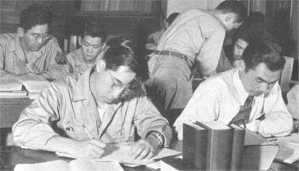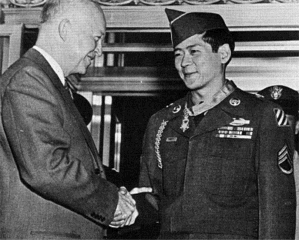Hosokawa, Nisei, Pg.407 picture link
"Nisei infantryman move up through mud of a heavily forested area in Southern France during rescue of the Lost Battalion in October 1944" (US Army photo)
|
Japanese Americans in the Military |
Hosokawa, Nisei, Pg.407 picture link
"Nisei infantryman move up through mud of a heavily forested area in Southern France during rescue of the Lost Battalion in October 1944" (US Army photo)
|
Japanese Americans faced many hard decisions during the war, and one that faced many young men was whether or not they would serve for a country that viewed them as potential traitors. For many serving in the army was an opportunity to prove their loyalty to America, however for some, the idea of serving a country that had imprisoned them and their families in concentration camps was entirely repugnant. After Pearl Harbor men of Japanese ancestry were unable to volunteer for the armed forces, and those that had before the war were discharged. In Hawaii few Japanese Americans were actually interned to the mainland. More. However their official status was ‘4c’, which meant that despite the fact they were citizens, they were technically classed as enemy aliens. Hence the National Guard and Territorial Army discharged all men of Japanese ancestry. However, a large number of men were determined to help the war effort and volunteered for a variety of menial tasks. Their hard work led to General George C. Marshall overturning the decision not to allow Japanese Americans to serve, so that a special unit could be formed. This became known as the 100th Infantry Battalion. The Battalion was made up of 1 300 men, and 29 commanding officers. |

Yoo, Growing Up Nisei pg. 105 Nisei soldiers of the 4th Platoon, Company F, October 1944 |
Their excellent performance during the war led to the army being pressured to allow Japanese Americans to join the army again in February 1943. Once the army was opened up to Japanese Americans again, thousand volunteered for the segregated Nisei unit, the 442 Regimental Combat Team. It had been expected that in total 4000 Nisei would be able to volunteer, 1 500 from Hawaii and 300 from the mainland. However, surprising the army, nearly 10 000 Nisei from Hawaii volunteered, (only 2 600 were accepted) and from the mainland and the internment camps 1 256 volunteered. |
| They were under incredible pressure to prove themselves worthy and to show that they were good American citizens. However for many young men the turmoil of being sent to the Pacific theatre, where they might actually face people that they knew. Takejiro Higa a solider in the Military Intelligence Service, felt torn, mainly because he had spent a large part of his childhood growing up in Japan, therefore he considered both Japan and America to be his homelands. “It put me in terrible turmoil psychologically, because if the unit was to be made up of Japanese speaking Americans of Japanese ancestry, it was understood I’d be sent to the Pacific war front. What if I came face to face with someone I knew-a relative, a classmate? It might not happen, but it was possible. I felt torn by that fear and my desire to serve my country.” (Japanese Eyes 793). |
|
The Military Intelligence Service The Military Intelligence Service (MIS) was designed for Japanese Americans who had some knowledge of their ancestor’s language to aid the American military in the Pacific and Asia. In 1941 a language school was established in San Francisco that would help teach Japanese Americans to be fluent in the Japanese language. |

Hosokawa, Nisei, pg.402 Nisei in the Intelligence Service |
| In total 5000 Japanese Americans
were apart of the MIS, helping to translate Japanese documents and
interrogating prisoners.
It was believed that when a Japanese prisoner of war saw a face that was similar to his own he would be more cooperative, because war propaganda had convinced many Japanese citizens that the Americans would treat them brutally. The unit is generally viewed as a success because it is believed that without the linguists many blunders would have been made, and many more lives, including those of Japanese citizens would have been lost. |

Hosokawa, Nisei pg. 415 Sergeant Hershey Miyamura, 2nd Nisei to win the Medal of Honor, congratulated by Eisenhower |
Despite the challenges that these men faced, they proved themselves to be extremely brave, and to be one of the most decorated military units in America. Despite the fact that at any one time the two units combined never numbered more than 4 500, in total there were 18 143 decorations, including 3 600 Purple Hearts awarded. |